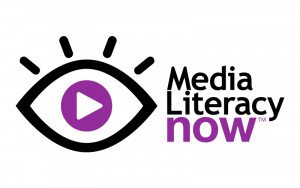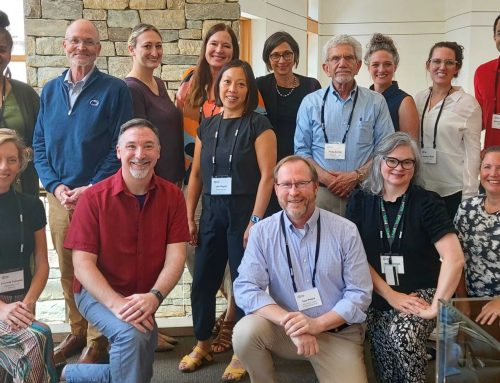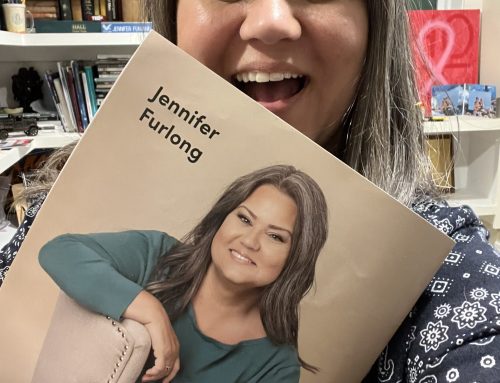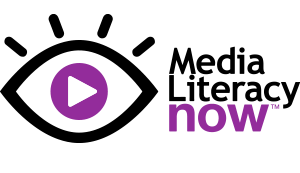Hi, I’m Erin McNeill. My background is in journalism. I’m also a former U.S. Army reservist with jump wings earned at Fort Benning, Georgia. I reported on riots and natural disasters, city politics and business in San Francisco. Then I went to Washington D.C. and wrote about environmental policy and legislation. More recently, I covered economic policy in Congress.
And, I’m a parent of two wonderful young men, raised with my husband during a time of world-altering communications technology change. Which is why I started this media literacy journey.
It began because I had a lot of questions when my boys were young. I wondered why the cartoons they watched on commercial television showed boys making googly eyes at the girls. And the girls had on these skimpy outfits. My little boys weren’t interested in girls yet. Girls were just other kids at school. If their interests aligned, they would play together. If not, no big deal. And they certainly didn’t understand the concept of staring at girls and saying “hubba hubba.” Why was this version of male behavior being pushed on them I wondered? And why were they being trained from such an early age in gender stereotypes? Why this emphasis on the differences between boys and girls?
Now, what about when a small child sees violence on television? I really started to wonder about this when my small boys witnessed a commercial during a Patriots football game in which a teen-aged boy was shot. What does that image do when it gets inside those young brains and bounces around?
Then, there were the advertisements on television. When a boy of 6 or 8 or 10 sees soft porn in the form of a Victoria’s Secret commercial during a Red Sox game, I wondered: How does that affect him? What is it doing to the social and sexual development of young males? Are their brains getting flooded prematurely with hormones, and will that be a problem later? And is that fair to our boys?
We would watch children’s movies together as a family. Nearly everyone is male in children’s animated movies. Every preschooler knows that worker bees are all female. Yet, we get the Bees movie, with all-male worker bees. Jungle Book has a herd of male elephants, although we learned on our very first trip to the zoo that elephants travel in packs of females. If there was any female character in the movie, she was usually the only one. What is her role? To be the “female” one. Take for example the movie Madagascar. There’s the smart one, the adventurous one, the dopey one, and the female one. She bats her eyelashes a lot. Is it possible that there is more than one “female” personality? This is the kind of thing I brought up at the dinner table. Ten years later, I am sure you see the same thing in recent children’s movies.
I knew there was a problem. The influence of media was far more pervasive than when I grew up. Commercial media was taking away our right and our privilege – as a society and as individual parents – to form and shape our young people. I knew we couldn’t expect parents to just block out the dominant and powerful media in our society. That would be both impossible, and not a positive way for parents to help prepare their children for the real world.
I started a blog, Marketing Media & Childhood, to explore these questions and more – stereotypes, commercialization, messages that try to tell a child what he or she should aspire to be. The blog gave me an opportunity to call people across the country to ask them these questions and learn about marketing to children and media influences on children. I met with and talked to a wide range of people including teachers, librarians, and nurses; advocacy groups with media education curriculum to assist interested teachers; researchers studying the impact of media on youth and the effectiveness of media literacy education; concerned parents; advocacy groups for a wide range of children’s issues; and others. It became clear to me that a big part of the solution is media literacy, comprehensively taught to all children from a young age. To provide guidance from professional teachers to our young people, to help them understand the messages they were getting, where they were coming from, and that they didn’t necessarily have to accept them. To teach them how to use media for their own purposes, without being used by it.
My awareness of the issue grew from my own observations from discussions with teachers, parents and researchers. Media shapes our values, our behavior, and our attitudes. It touches almost every aspect of our lives. Media has an effect on our children’s physical and mental health, and also impacts social justice and women’s progress. Media can impact the economy when the messages children receive limit their aspirations, and so limit our available talent and skills. Today we know very well that media affects our very democracy as we’ve seen how influencers from both within and outside the country have altered the conversation – from unethical media outlets amping up the outrage for profit, to foreign state use of social media to inject misinformation and disinformation into our public discourse. We’ve also come to realize that extremist groups are recruiting online, unscrupulous corporations have marketed opioids to the point of a major epidemic, giant media corporations are vacuuming up every bit of information about us to sell, which it turns out is not just for selling us stuff, but for selling us ideas (see Cambridge Analytica). Beyond that, there’s massive surveillance by local, regional and national government, which will change the way we think, act, and exercise our rights as citizens. Meanwhile we’ve left our children alone in the wild west of social media, where they sometimes find joy, but all too often find emotional hurt.
Media literacy, though, empowers students, and all of us, to question messages and tell their own stories, and to participate in a global media environment. And there are many positives beyond that: Media literacy is highly engaging for students, is a very effective way to teach literacy, supports civic engagement, and is seen as a key 21st century communication skill by business leaders. Media literacy is essential today for health, well-being, and economic participation.
So then, if this is clearly so important for our youth in this era of 24/7 media, why is it not being taught in our schools? It was not even on the public policy agenda when I got started back in 2011. Few people even know what media literacy is. Yet, schools spend considerable effort attempting to counteract the ideas, attitudes, and behavior that children pick up from the media.
One day, I talked to my son’s 5th grade teacher about the need for media literacy education. She agreed, and created a three unit advertising deconstruction lesson plan for her students, using resources available online. She introduced it in June, after standardized testing was completed, and when kids had a tendency to be tuning out. The level of engagement from the students was amazing. They had so much to say.
She told me a now very familiar story: The problem for teachers is that they are often pushing against their school administrators, who have filled the schedule with very specific curriculum that has to be covered. There is little room to go outside that to cover what many teachers see as vital. And those administrators of course are responding to the state’s expectations. Soon afterward I worked with that teacher, the school librarian, the school nurse and the school principal to obtain a grant for middle school teacher training in media literacy.
Through my blog I came to realize the problem was worse than I thought, but I was also heartened to learn that there were many other concerned parents, pockets of teachers pushing for media literacy, and research-based advocacy groups developing curriculum that teachers could use. The one thing that was missing, which was brought home to me by my son’s teacher, was that media literacy needed to be a matter of education policy and no one was working on that.
I realized we needed to go to the policy makers, to make media literacy a priority in schools, which would give teachers the room to teach it and shift curriculum development resources and teacher training toward media literacy. We needed to put media literacy on the agenda.
In 2011, I worked with state Senator Katherine Clark in Massachusetts to introduce a bill that called for Department of Elementary and Secondary Education support for providing media literacy standards, resources and training for teachers of grades K through 12. I gathered other like-minded people. When the hearing date was set, we had only about a week to prepare, but 11 people showed up to provide testimony – including students who told powerful stories. Dozens more submitted written testimony. It was a watershed moment. All of a sudden, media literacy was on the agenda. It was clear we had opened the eyes of a number of people on the panel.
I thought “Great, that’s done.” We had made a strong case that this is clearly an urgent issue. Surely the committee will immediately pass this common sense, and not-too-onerous bill so that we can have a debate on the House and Senate floor. We were not even asking for an appropriation, just a shift in Department of Education priorities. Through my research I found numerous examples of lesson plans and curriculum that would weave media literacy into the current K-12 curriculum through English, Social Studies, Health, and other classes. We kept gathering supporters and endorsers, including the teachers’ union, held meetings with legislators and… the bill died in committee. It turns out legislation is very difficult to move without a very clear, acute crisis.
However, one thing I learned was that introducing legislation creates excitement. It’s the engine that drives advocacy. It gives proponents something to grab onto and build a coalition around.
It was becoming clear by the time of the second hearing in the next session of the Massachusetts legislature that this was going to be a long haul. It wasn’t just about pointing out truth. It was about educating people from the loftiest levels to the ground level, gathering momentum, and demanding that our leaders address this issue.
I was already hearing from people around the country who were thinking about doing something similar in their states. I realized we needed to get this effort rolling in many states, because it is urgent and we cannot afford to wait. In September 2013, I launched the national organization, Media Literacy Now, to help passionate activists in every state get a running start, giving them the tools and sharing the experience we had developed in Massachusetts so they too could put media literacy on the agenda.
Change happens at the state level, and I believe once we have a critical mass, we will turn the ship of education policy. We may have to take tiny steps at first, but eventually we will gather steam and while many states will make a small change, a leader is going to step forth and ensure that all students, K-12 are getting the comprehensive media literacy skills that they need in the 21st century to lead safe, healthy and productive lives.
By the end of the first year, Media Literacy Now was guiding legislative efforts in three states: Massachusetts, New York and New Jersey. Within another few months, a fourth state – Connecticut – had introduced legislation and I was working with leaders in a dozen states, partnering with existing organizations or creating new chapters to build coalitions and seek legislative sponsorship. It’s clear that the time for this is now. The need has become so great and so clear that people are asking, “What do we do?” Policy makers are concerned about issues that are the result of failing to teach students how to use media safely, ethically and thoughtfully. But they aren’t sure what the answer is. Parents are overwhelmed and desperate. Schools are caught in the middle.
But change is happening. Businesses are recognizing that media literacy is key to the economy. Women’s groups and vulnerable communities recognize the need for media literacy for equality and progress. Pediatricians and mental health experts recognize the urgent need in terms of health. Civics proponents see that media literacy is key to preserving and strengthening citizen engagement in a nation where government is encoded as by the people and for the people – the very foundations of democracy. Media Literacy Now is making a difference by showing the way.




